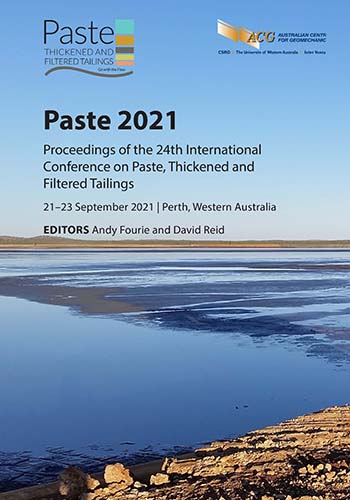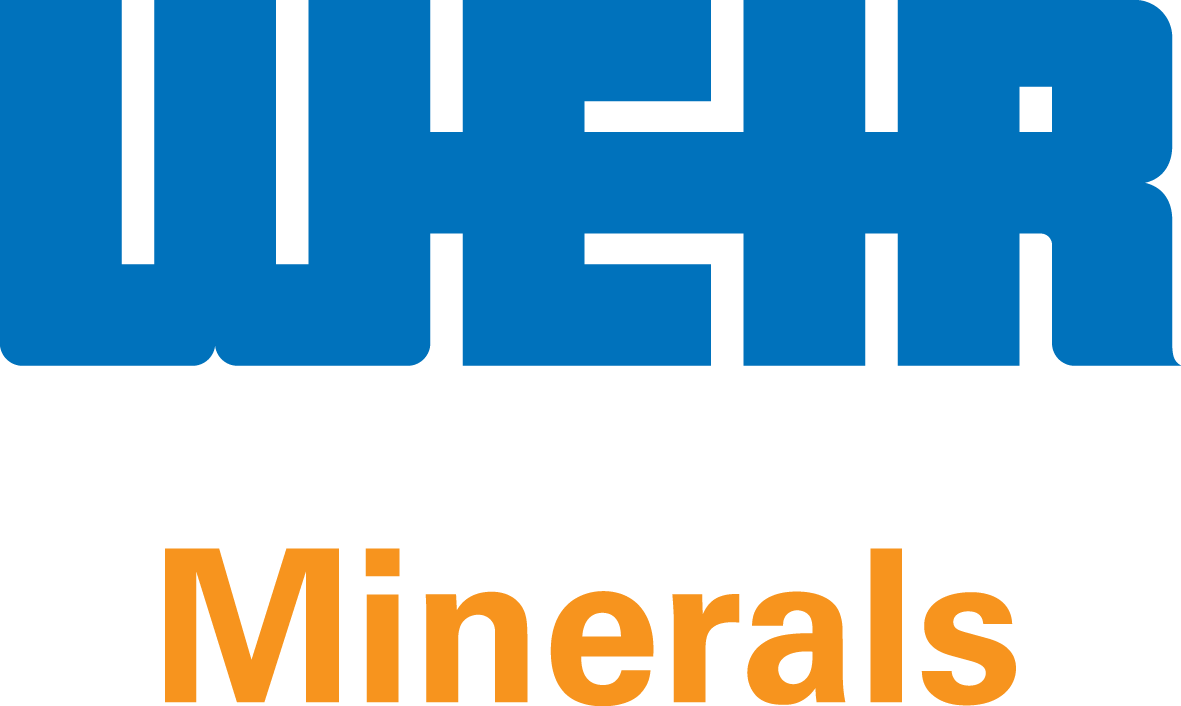Investigation of geotechnical, hydromechanical, and chemical behaviour of polymer-treated tailings

|
Authors: Boshrouyeh Ghandashtani, M; Edraki, M; Costine, A; Baumgartl, T |
DOI https://doi.org/10.36487/ACG_repo/2115_08
Cite As:
Boshrouyeh Ghandashtani, M, Edraki, M, Costine, A & Baumgartl, T 2021, 'Investigation of geotechnical, hydromechanical, and chemical behaviour of polymer-treated tailings', in AB Fourie & D Reid (eds), Paste 2021: Proceedings of the 24th International Conference on Paste, Thickened and Filtered Tailings, Australian Centre for Geomechanics, Perth, pp. 79-90, https://doi.org/10.36487/ACG_repo/2115_08
Abstract:
This study investigated the properties of flocculated materials formed in a laboratory-scale inline flocculation setup at a high solid concentration of artificial tailings. Water scarcity and the willingness of using seawater in mineral processing where access to fresh water is limited highlights the importance of understanding the salinity effects on the tailings treatment processes. To better understand the inline flocculation technique for enhanced water recovery from fine-particle suspensions, this paper studied the impacts of two typical salts, NaCl and CaCl2 on the geotechnical, hydrological, hydromechanical, and chemical behaviour of polymertreated synthetic tailings slurry using a low-shear mixer for continuous flocculation under controlled conditions. A standard consolidation test was used to investigate the differences in geotechnical properties and functions between the raw and polymer-treated tailings in presence of added salt. Increasing the calcium concentration was more adversely impacted by the low molecular weight (MW) copolymers in producing aggregates with lower water recovery and turbidity and gave the greatest zeta potential compared to other polymer chemistry. Among the polyacrylamide/polyacrylate copolymers, Magnafloc® 5250 flocculant responded more effectively at the low CaCl2 salinity by producing higher zeta potential and fast realising of the less turbid water compared to that of NaCl. Greater compatibility between the high NaCl salinity with the high MW copolymer was also exhibited in terms of facilitating the polymer chains activities to create stronger aggregates. The saturated hydraulic conductivity of samples was evaluated, and the pore size distribution was analysed by determination of the water retention characteristics of the materials. Results indicated a significant difference in geotechnical and hydrological properties between the untreated and polymer-treated slurries, including: (i) a higher void ratio for the polymer-treated samples containing CaCl2; (ii) different patterns of settlement under the applied vertical stress during consolidation of the specimens; and (iii) 40% more free water drainage from samples salted with CaCl2 and treated by adding polymer. The results are discussed in light of the contribution of the polymer treatment to improved rehabilitation outcomes and the role geotechnical, hydromechanical, hydrological and chemical properties play to achieve this goal.
Keywords: inline flocculation, dewatering rate, consolidation, aggregates microstructure, water recovery, salinity
References:
Arinaitwe, E & Pawlik, M 2013, ‘A role of flocculant chain flexibility in flocculation of fine quartz. Part I. Intrinsic viscosities of polyacrylamide-based flocculants’, International Journal of Mineral Processing, vol. 124, pp. 50–57,
Assouline, S & O, Dani 2014, ‘The concept of field capacity revisited: defining intrinsic static and dynamic criteria for soil internal drainage dynamics’, Water Resources Research, vol. 50, no. 6, pp. 4787–4802,
Costine, A, Benn, F, Fawell, P, Edraki, M, Baumgartl, T & Bellwood, J 2018a, ‘Understanding factors affecting the stability of inline polymer-amended tailings’, in RJ Jewell & AB Fourie (eds), Paste 2018: Proceedings of the 21st International Seminar on Paste and Thickened Tailings, Australian Centre for Geomechanics, Perth, pp. 103–116,
1805_08_Costine
Costine, A, Cox, J, Travaglini, S, Lubansky, A, Fawell, P & Misslitz, H 2018b, ‘Variations in the molecular weight response of anionic polyacrylamides under different flocculation conditions’, Chemical Engineering Science, vol. 176, pp. 127–138,
Costine, A, Fawell, P, Chryss, A, Dahl, S & Bellwood, J 2020, ‘Development of test procedures based on chaotic advection for assessing polymer performance in high-solids tailings applications’, Processes, vol. 8, no. 6,
Costine, A, Lester, DR, Fawell, P & Chryss, A 2014, ‘Shear isn’t mixing: how to build larger aggregates using chaotic advection for accelerated dewatering’, in R Jewell, AB Fourie, PS Wells, D van Zyl (eds), Paste 2014: Proceedings of the 17th International Seminar on Paste and Thickened Tailings, InfoMine, Vancouver Inc., p. 644.
de Oliveira, RA, Ramos, MM & de Aquino, LA 2015, ‘Irrigation management’, Sugarcane: Agricultural Production, Bioenergy and Ethanol, Academic Press, Cambridge,
Du, J, Morris, G, Pushkarova, RA & Smart, R St C, 2010, ‘Effect of surface structure of kaolinite on aggregation, settling rate, and bed density’, Langmuir, vol. 26, pp. 13227–13235,
Fawell, PD, Costine, AD & Grabsch, AF 2015, ‘Why small-scale testing of reagents goes wrong’, in R Jewell & AB Fourie (eds), Paste 2015: Proceedings of the 18th International Seminar on Paste and Thickened Tailings, Australian Centre for Geomechanics, Perth, pp. 153–165,
Ghirian, A & Fall, M 2013, ‘Coupled thermo-hydro-mechanical-chemical behaviour of cemented paste backfill in column experiments. Part I: Physical, hydraulic and thermal processes and characteristics’, Engineering Geology, vol. 164, pp. 195–207,
Hilton, M, Shaygan, M, McIntyre, N, Baumgartl, T & Edraki, M 2019, ‘The effect of weathering on salt release from coal mine spoils’, Minerals, vol. 9, no. 12,
Islam, S, Williams, DJ, Llano-Serna, M & Zhang, C 2020, ‘Settling, consolidation and shear strength behaviour of coal tailings slurry’, International Journal of Mining Science and Technology, vol. 30, issue 60, pp. 849–857,
j.ijmst.2020.03.013
Jcu, R 2004, The Geotechnical Characterisation and Stability Analysis of BHP Billiton’s Cannington Mine Paste Fill, PhD thesis, James Cook University, Townsville.
Jeeravipoolvarn, S 2010, Geotechnical Behavior of In-Line Thickened Oil Sands Tailings, PhD thesis, Univeristy of Alberta, Edmonton.
Pearse, MJ 2003, ‘Historical use and future development of chemicals for solid – liquid separation in the mineral processing industry’, Minerals Engineering, vol. 16, issue 2, pp. 103–108,
Pinheiro, M, Sobkowicz, J, Boswell, J & Wells, S 2012, ‘Modelling of the deposition profile of in-line flocculated mature fine tailings in beach cells’, Proceedings of Geo-Manitoba 2012: 65th Canadian Geotechnical Conference, Canadian Geotechnical Society.
Rai, RK, Singh, VP & Upadhyay, A 2017, ‘Chapter 17 - soil analysis’, Planning and Evaluation of Irrigation Projects: Methods and Implementation, in RK Rai, VP Singh & A Upadhyay (eds), Academic Press, pp. 505–523,
Ramos, J, Leiva, WH, Castillo, C, Ihle, CF, Fawell, PD & Jeldres, RI 2020, ‘Seawater flocculation of clay-based mining tailings: impact of calcium and magnesium precipitation’, Minerals Engineering, vol. 154,
Reid, C, Bécaert, V, Aubertin, M, Rosenbaum, RK & Deschênes, L 2009, ‘Life cycle assessment of mine tailings management in Canada’, Journal of Cleaner Production, vol. 17, issue 4, pp. 471–479,
Reid, D & Fourie, AB 2016, ‘Laboratory assessment of the effects of polymer treatment on geotechnical properties of low-plasticity soil slurry’, Canadian Geotechnical Journal, pp. 1718–1730.
Sabah, E & Cengiz, I 2004, ‘An evaluation procedure for flocculation of coal preparation plant tailings’, Water Research, vol. 38, issue 6, pp. 1542–1549,
Shaygan, M, Reading, LP & Baumgartl, T 2017, ‘Effect of physical amendments on salt leaching characteristics for reclamation’, Geoderma, vol. 292, pp. 96–110,
Shukla, SK, Sivakugan, N & Das, BM 2009, ‘Methods for determination of the coefficient of consolidation and field observations of time rate of settlement — an overview’, Internatonal Journal Geotechnical Engineering, vol. 3, issue 1, pp. 89–108,
Tombácz, E & Szekeres, M 2004, ‘Colloidal behavior of aqueous montmorillonite suspensions: the specific role of pH in the presence of indifferent electrolytes’, Applied Clay Science, vol. 27, issues 1–2, pp. 75–94,
Torres Lopez, C, Catling, M, Bellwood, J & Boxill, L 2019, ‘The effect of preconditioning of tailings prior to inline flocculation and deposition’, in AJC Paterson, AB Fourie & D Reid (eds), Paste 2019: Proceedings of the 22nd International Conference on Paste, Thickened and Filtered Tailings, Australian Centre for Geomechanics, Perth, pp. 285–293,
ACG_rep/1910_19_Torres_Lopez
Watson, P, Farinato, R, Fenderson, T, Hurd, M, Macy, P & Mahmoudkhani, A 2011, ‘Novel polymeric additives to improve oil sands tailings consolidation’, paper presented at the SPE International Symposium on Oilfield Chemistry, The Woodlands, 11–13 April 2011,
Wells, P, Revington, A & Omotoso, O 2011, ‘Mature fine tailings drying — technology update’, in R Jewell & AB Fourie (eds), Paste 2011: Proceedings of the 14th International Seminar on Paste and Thickened Tailings, Australian Centre for Geomechanics, Perth, pp. 155–166,
Williams, PA (ed.) 2007, Handbook of Industrial Water Soluble Polymers, Blackwell Publishing Ltd, Hoboken,
Yang, X & You, X 2013, ‘Estimating parameters of van genuchten model for soil water retention curve by intelligent algorithms’, Applied Mathematics & Information Sciences, vol. 7, no. 5, pp. 1977–1983,
Yu, H 2015, Geotechnical Properties and Flow Behaviour of Coal Refuse Under Static and Impact Loading, Case Western Reserve University, Cleveland.
© Copyright 2025, Australian Centre for Geomechanics (ACG), The University of Western Australia. All rights reserved.
View copyright/legal information
Please direct any queries or error reports to repository-acg@uwa.edu.au
View copyright/legal information
Please direct any queries or error reports to repository-acg@uwa.edu.au





